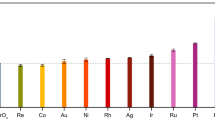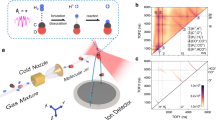Abstract
The hydroxyl radical is an important atmospheric oxidant, and a significant source of its production occurs through alkene ozonolysis. This takes place via a cycloaddition reaction and subsequent fragmentation to form an energized carbonyl oxide (for example, CH3CHOO), known as a Criegee intermediate, which can then either react with another atmospheric species or decay and, in doing so, produce the hydroxyl radical. Here, we examine the dissociation dynamics of a prototypical Criegee intermediate by characterizing the translational and internal energy distributions of the OH radical products, which reflect critical configurations along the reaction pathway. Experimentally, the kinetic energy release to OH products is ascertained through velocity map imaging. Theoretically, quasi-classical trajectories are performed on a new full-dimensional, ab initio potential energy surface. Both experiment and theory show that most of the available energy flows into internal excitation of the vinoxy products. The isotropic angular distribution of OH fragments indicates that dissociation occurs in ≥2 ps, in agreement with theory.
This is a preview of subscription content, access via your institution
Access options
Subscribe to this journal
Receive 12 print issues and online access
$259.00 per year
only $21.58 per issue
Buy this article
- Purchase on Springer Link
- Instant access to full article PDF
Prices may be subject to local taxes which are calculated during checkout






Similar content being viewed by others
References
Stone, D., Whalley, L. K. & Heard, D. E. Tropospheric OH and HO2 radicals: field measurements and model comparisons. Chem. Soc. Rev. 41, 6348–6404 (2012).
Harrison, R. M. et al. Measurement and modelling of air pollution and atmospheric chemistry in the UK West Midlands conurbation: overview of the PUMA Consortium project. Sci. Total Environ. 360, 5–25 (2006).
Emmerson, K. M. et al. Free radical modelling studies during the UK TORCH campaign in summer 2003. Atmos. Chem. Phys. 7, 167–181 (2007).
Emmerson, K. M. & Carslaw, N. Night-time radical chemistry during the TORCH campaign. Atmos. Environ. 43, 3220–3226 (2009).
Johnson, D. & Marston, G. The gas-phase ozonolysis of unsaturated volatile organic compounds in the troposphere. Chem. Soc. Rev. 37, 699–716 (2008).
Osborn, D. L. & Taatjes, C. A. The physical chemistry of Criegee intermediates in the gas phase. Int. Rev. Phys. Chem. 34, 309–360 (2015).
Lee, Y. P. Perspective: spectroscopy and kinetics of small gaseous Criegee intermediates. J. Chem. Phys. 143, 020901 (2015).
Chao, W., Hsieh, J. T., Chang, C. H. & Lin, J. J. M. Direct kinetic measurement of the reaction of the simplest Criegee intermediate with water vapor. Science 347, 751–754 (2015).
Lewis, T. R., Blitz, M. A., Heard, D. E. & Seakins, P. W. Direct evidence for a substantive reaction between the Criegee intermediate, CH2OO, and the water vapour dimer. Phys. Chem. Chem. Phys. 17, 4859–4863 (2015).
Liu, F., Fang, Y., Kumar, M., Thompson, W. H. & Lester, M. I. Direct observation of vinyl hydroperoxide. Phys. Chem. Chem. Phys. 17, 20490–20494 (2015).
Orzechowska, G. E. & Paulson, S. E. Production of OH radicals from the reactions of C4–C6 internal alkenes and styrenes with ozone in the gas phase. Atmos. Environ. 36, 571–581 (2002).
IUPAC. IUPAC Subcommittee on Gas Kinetic Data Evaluation, Data sheet Ox_VOC3_O3 (2005), http://www.iupac-kinetic.ch.cam.ac.uk/datasheets/pdf/Ox_VOC3_O3_alkene.pdf
Paulson, S. E. & Orlando, J. J. The reactions of ozone with alkenes: an important source of HOx in the boundary layer. Geophys. Res. Lett. 23, 3727–3730 (1996).
Taatjes, C. A. et al. Direct measurements of conformer-dependent reactivity of the Criegee intermediate CH3CHOO. Science 340, 177–180 (2013).
Liu, F., Beames, J. M., Petit, A. S., McCoy, A. B. & Lester, M. I. Infrared-driven unimolecular reaction of CH3CHOO Criegee intermediates to OH radical products. Science 345, 1596–1598 (2014).
Beames, J. M., Liu, F., Lu, L. & Lester, M. I. UV spectroscopic characterization of an alkyl substituted Criegee intermediate CH3CHOO. J. Chem. Phys. 138, 244307 (2013).
Beames, J. M., Liu, F., Lester, M. I. & Murray, C. Communication: A new spectroscopic window on hydroxyl radicals using UV + VUV resonant ionization. J. Chem. Phys. 134, 241102 (2011).
Beames, J. M., Liu, F. & Lester, M. I. 1+1′ resonant multiphoton ionisation of OH radicals via the A2Σ+ state: insights from direct comparison with AX laser-induced fluorescence detection. Mol. Phys. 112, 897–903 (2014).
Kurten, T. & Donahue, N. M. MRCISD studies of the dissociation of vinylhydroperoxide, CH2CHOOH: there is a saddle point. J. Phys. Chem. A 116, 6823–6830 (2012).
Mordaunt, D. H., Osborn, D. L. & Neumark, D. M. Nonstatistical unimolecular dissociation over a barrier. J. Chem. Phys. 108, 2448–2457 (1998).
Brouard, M. Reaction Dynamics (Oxford Univ. Press, 1998).
Drozd, G. T., Kroll, J. & Donahue, N. M. 2,3-Dimethyl-2-butene (TME) ozonolysis: pressure dependence of stabilized Criegee intermediates and evidence of stabilized vinyl hydroperoxides. J. Phys. Chem. A 115, 161–166 (2011).
Liu, F., Beames, J. M. & Lester, M. I. Direct production of OH radicals upon CH overtone activation of (CH3)2COO Criegee intermediates. J. Chem. Phys. 141, 234312 (2014).
Lin, H. Y. et al. Infrared identification of the Criegee intermediates syn- and anti-CH3CHOO, and their distinct conformation-dependent reactivity. Nature Commun. 6, 1–7 (2015).
Adler, T. B., Knizia, G. & Werner, H. J. A simple and efficient CCSD(T)-F12 approximation. J. Chem. Phys. 127, 221106 (2007).
Knizia, G., Adler, T. B. & Werner, H. J. Simplified CCSD(T)-F12 methods: theory and benchmarks. J. Chem. Phys. 130, 054104 (2009).
Braams, B. J. & Bowman, J. M. Permutationally invariant potential energy surfaces in high dimensionality. Int. Rev. Phys. Chem. 28, 577–606 (2009).
Fang, Y. et al. Communication: real time observation of unimolecular decay of Criegee intermediates to OH radical products. J. Chem. Phys. 144, 061102 (2016).
Lehman, J. H., Li, H., Beames, J. M. & Lester, M. I. Communication: ultraviolet photodissociation dynamics of the simplest Criegee intermediate CH2OO. J. Chem. Phys. 139, 141103 (2013).
Li, H., Fang, Y., Beames, J. M. & Lester, M. I. Velocity map imaging of O-atom products from UV photodissociation of the CH2OO Criegee intermediate. J. Chem. Phys. 142, 214312 (2015).
Li, H., Fang, Y., Kidwell, N. M., Beames, J. M. & Lester, M. I. UV photodissociation dynamics of the CH3CHOO Criegee intermediate: action spectroscopy and velocity map imaging of O-atom products. J. Phys. Chem. A 119, 8328–8337 (2015).
Nakajima, M. & Endo, Y. Communication: Spectroscopic characterization of an alkyl substituted Criegee intermediate syn-CH3CHOO through pure rotational transitions. J. Chem. Phys. 140, 011101 (2014).
Chang, Y. T., Minichino, C. & Miller, W. H. Classical trajectory studies of the molecular dissociation dynamics of formaldehyde: H2CO→H2+CO. J. Chem. Phys. 96, 4341–4355 (1992).
Rheinecker, J. L., Zhang, X. & Bowman, J. M. Quasiclassical trajectory studies of the dynamics of H2CO on a global ab initio-based potential energy surface. Mol. Phys. 103, 1067–1074 (2005).
Kuwata, K. T., Hermes, M. R., Carlson, M. J. & Zogg, C. K. Computational studies of the isomerization and hydration reactions of acetaldehyde oxide and methyl vinyl carbonyl oxide. J. Phys. Chem. A 114, 9192–9204 (2010).
Donahue, N. M., Drozd, G. T., Epstein, S. A., Presto, A. A. & Kroll, J. H. Adventures in ozoneland: down the rabbit-hole. Phys. Chem. Chem. Phys. 13, 10848–10857 (2011).
Novelli, A., Vereecken, L., Lelieveld, J. & Harder, H. Direct observation of OH formation from stabilised Criegee intermediates. Phys. Chem. Chem. Phys. 16, 19941–19951 (2014).
Acknowledgements
The experimental research (M.I.L.) was supported by the US Department of Energy, Basic Energy Sciences (DE-FG02-87ER13792). The theoretical research (J.M.B.) was supported by the US Department of Energy, Basic Energy Sciences (DE-FG02-97ER14782). The authors thank F. Liu (University of Pennsylvania) for discussions. J.M.B. and X.W. also thank F. Evangelista (Emory University) for discussions about the active space in CASPT2 calculations.
Author information
Authors and Affiliations
Contributions
N.M.K., H.L. and X.W. contributed equally to this work. N.M.K. and H.L. performed the experiments and analysed the data. X.W. performed the theoretical calculations and analysed the results. M.I.L. and J.M.B. conceived the experiments and theoretical calculations, respectively, and co-wrote the paper with contributions from other authors. All authors discussed the results and commented on the manuscript.
Corresponding authors
Ethics declarations
Competing interests
The authors declare no competing financial interests.
Supplementary information
Supplementary information
Supplementary information (PDF 940 kb)
Supplementary information
Supplementary Movie 1 (MOV 2772 kb)
Rights and permissions
About this article
Cite this article
Kidwell, N., Li, H., Wang, X. et al. Unimolecular dissociation dynamics of vibrationally activated CH3CHOO Criegee intermediates to OH radical products. Nature Chem 8, 509–514 (2016). https://doi.org/10.1038/nchem.2488
Received:
Accepted:
Published:
Issue Date:
DOI: https://doi.org/10.1038/nchem.2488
This article is cited by
-
Deep learning study of tyrosine reveals that roaming can lead to photodamage
Nature Chemistry (2022)
-
Rapid unimolecular reaction of stabilized Criegee intermediates and implications for atmospheric chemistry
Nature Communications (2019)



